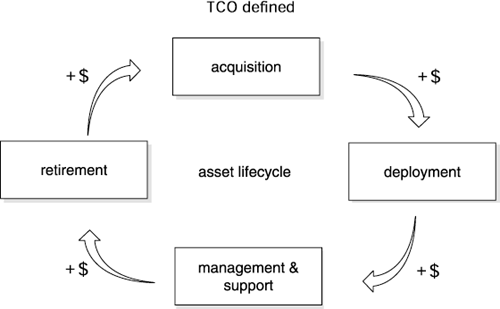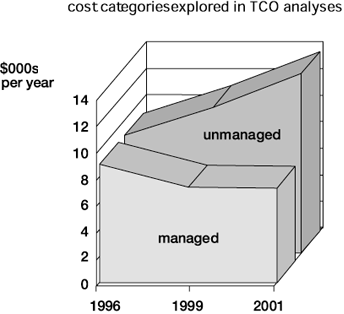TCO Methodology
The tools for measuring TCO have evolved rapidly, particularly for the client side of distributed computing environments. TCO has become a comprehensive set of methodologies, models, and tools to help organizations better in two ways: first, by improving overall value of IT investments, and second, by measuring, managing, and reducing costs. This can be expressed as a continual cycle of improvement, as demonstrated in Figure 9-2.
Figure 9-2. TCO Asset Life Cycle

The TCO is the cost of procuring, deploying, and maintaining management information systems. According to GartnerGroup, “A 10 percent saving in non-purchase costs—something most corporations can easily achieve through the adoption of HP management technologies—is the equivalent of a 50 percent saving in buying price.” It is purchase price, however, that often receives most of the attention when savings are sought; but here the market is so competitive that only a small percentage savings can be achieved. The purchase price is not the place to look for real savings.
Perhaps the most telling aspect of the continued integration of high-performance networks and computers today is that some costs continue to fall while other costs rise. As the cost of client/server hardware technology declines, the cost of managing this technology continues to escalate. While life cycle management costs climb, end-user satisfaction and productivity steadily fall. In that sense, many of the costs of any given system are hidden, similar to the way much of an iceberg's mass is hidden below the waterline, as in Figure 9-3.
Figure 9-3. Total Cost of Ownership

The initial purchase of hardware is a small expense in comparison to the dangers lurking “just below the surface.” The long-term costs of maintaining and supporting the computing infrastructure of a mission-critical environment include training, support, administration, asset tracking, and upgrades.
The result is that the TCO is of increasing interest to companies that want to better manage their environment. As seen in Figure 9-4, not managing these costs allows them to grow instead of decline.
Figure 9-4. Managed versus Unmanaged Costs

